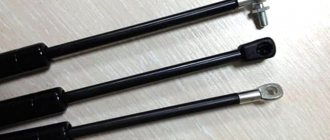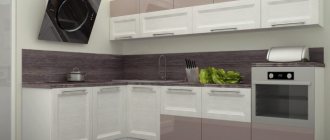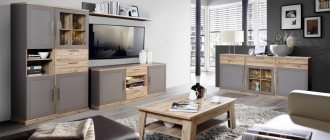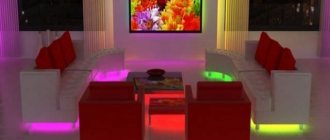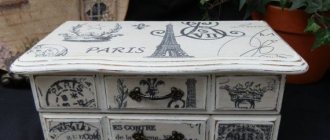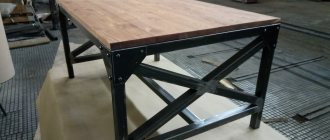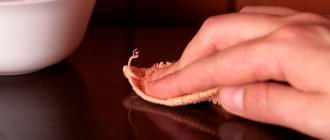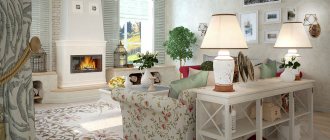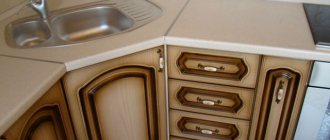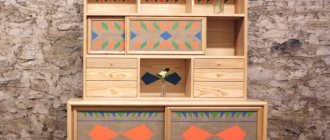“Everything new is well forgotten old!” This statement applies to many things. Furniture with a patina is no exception, which, before leaving the production workshop, has managed to “grow old.”
For many people, even the concept itself is unfamiliar. After all, if you have visited our website, it means you are trying to buy an original kitchen set, so in this article we will try to answer the following questions as fully as possible:
- What is patina and what does it have to do with furniture?
- Can a bed or kitchen with a patina be made from MDF?
- Is it possible to create a patina using technology with your own hands?
What is patina
All these unusual cracks, color and tint changes, an unusually spectacular appearance, imbued with antiquity and the wisdom of generations, are called patina. Patination technology was known in the ancient East. Initially, patina was an oxide film that, under certain conditions, quickly remained on bronze and copper products, transforming their appearance and increasing their value.
Later, the term patina began to be applied to wood and porcelain products. In this case, these were precisely signs of temporary aging - a web of light cracks, which gave the product a more sophisticated look. Unlike metal, where an oxide film could form quite quickly (for example, in a humid environment), the situation was more difficult with natural wood and porcelain - it took decades for their surfaces to begin to show noble signs of aging.
Thanks to modern patination technologies, there is no need to wait many years for the desired effect to appear - the natural process has been accelerated many times over. Modern patination is the artificial aging of new products by applying a special composition to their surface.
The emergence of patination in the modern world
Patina is a natural phenomenon to which metal and wood are exposed in natural conditions. It was originally seen on gold, silver and copper coins. Under the influence of the environment and time, a coating began to form on the surface, which gave objects a different appearance. The colors became brighter, cracks and darkening appeared. In this way, the process of surface oxidation, called patination, manifested itself. Items covered with such a coating were of high value. When looking at antique items, you can see the natural patina with the naked eye.
Furniture made from expensive solid wood ages nobly, so art connoisseurs strive to get it for their use. But the price of antiques is too high and not affordable for everyone. Taking into account the needs of people, modern technologists have developed a technique for artificial aging of wood and MDF. This innovation received the term “patination”.
Possibility of using technology at home
Previously, only natural wood and metal products could be artificially aged using patination. Today, such an opportunity has arisen for MDF, which has significantly expanded the spread of technology in kitchen interiors. Many manufacturers sell MDF kitchen facades with a silver, gold or black patina, which look very extravagant and impressive.
Is it possible to apply the technology at home yourself, since at first glance it is quite complicated? It's definitely possible! In this case, the first impression is deceptive and the complexity of the technology is greatly exaggerated. Probably because of the amazing end result. There are a huge number of master classes in the currently fashionable hand made direction, where all stages of the process are described in detail. There are entire groups and forums where users share tips and tricks, helping each other and teaching beginners the art of patination.
To begin with, you should choose an object for experimentation. It will be the MDF facade from the kitchen cabinet.
Patinated kitchen fronts
Patination of kitchen facades is a special way of artificially aging a product, creating a patina effect. Patinated kitchen facades are a fairly popular technique used by craftsmen and designers. The word patina itself means a greenish-brown coating that appears as a result of oxidation under the influence of the environment on bronze, copper, and brass objects.
What is patina and patination
Now the term patination or patina is used in a broader sense. Patination represents signs of noble aesthetic aging on various objects. Which are made not only of metal, but also of other materials. At the same time, patinated kitchen facades can be either wooden, made from solid wood, or natural wood. And from a more accessible and widespread material - MDF.
Patination of kitchen facades is an artificial aging of the surface of new facades, which gives the products the charm of antiquity and the nobility of the classics. To create a patina effect, kitchen facades undergo special treatment, as a result of which the color of the product is shaded and acquires a certain contrast.
Today, quite often the patination method can be seen on MDF facades, covered with PVC film or painted MDF facades. Patina looks especially good on film facades with a pattern, matching the color and texture of natural wood, with complex milling and imitation of frames and panels. If the kitchen facade has complex deep milling, patination can successfully highlight the milling pattern.
patinated kitchen fronts
The process of patination of kitchen facades
There are many methods and methods for patination of furniture facades. In this case, you can use special paints, varnishes and compositions. For example, in the store you can find special compositions that are called “Patina” and differ from each other in the resulting visual effect. Depending on the name of the composition: “Golden Patina” or “Green Patina”, these substances create different types of patina on the surface of the decorated product: blue, rusty, green. Before using such compositions, you must carefully read the instructions. Since the methods of using various materials for patination differ significantly from each other.
Patinated kitchen facades can be ordered ready-made from a furniture factory. Or you can get creative and create a patina effect on your kitchen cabinets yourself.
Below we describe one of the many ways to patina a kitchen facade made of MDF.
First, using a spray bottle, you need to apply a thin layer of insulator to the surface of the facade. That is, the adhesive barrier is a primer intended for laminated surfaces. Then apply a colorless polyurethane primer. After which you need to finely sand the second layer with colorless primer.
patina on facades
Next, the patina itself is applied directly. As an applied product, special compositions can be used, which are called patina or special paints and varnishes with special effects. For example, with the effect of gilding, mother-of-pearl or metallic effect.
After applying the patination composition to the surface of the facade, the patina needs to be processed. Depending on the desired effect, the patina treatment may vary. To treat the surface to be patinated, you can use a scraper, steel wool, a piece of foam rubber, etc.
The resulting visual patina effect must be secured and protected from external influences using one, usually two layers of varnish. Varnish can be polyurethane or acrylic, glossy or matte.
patinated fronts in the kitchen
A kitchen with patinated facades looks solid, elegant and noble. And due to the fact that the patinated surface is covered with a protective varnish, the kitchen facade is quite resistant to abrasion, mechanical and chemical influences.
Categories
- Accessories and dishes
- Decor and design
- Accessories
- Furniture for kitchen
- Sinks and mixers
- Filling sections
- Layout
- Useful tips
- Kitchen manufacturers
- Kitchen renovation
- Recipes and products
- Style
- Tabletops
- Large equipment
- Small equipment
- Apron
- Facades
- Color
Feedback(C) 2014-2021 Any full or partial copying of site materials is permitted only if there is an active link to the Kitchen Project website. | Site Map
vote
Article rating
Selecting tools and materials
To quickly and effectively age our MDF facade, we do not need specialized tools and accessories. Everything is bought at a hardware store, and a set of tools for patination will not cost much. List of materials and tools that will be needed to apply patina on the facade at home:
- directly, the kitchen MDF facade itself. You can buy a new one at a hardware store, or you can unscrew any door from your kitchen unit;
- spray;
- paint brushes of different thicknesses;
- metal scourer for washing dishes;
- polyurethane primer (colorless);
- insulator (soil barrier);
- coating for applying special effects (aka patina);
- clear finishing varnish;
- protective equipment (gloves, goggles).
Patination defects and causes of their occurrence
Only single bubbles, craters with a diameter of no more than 1 mm, punctures, mechanical inclusions with a size of no more than 1 mm, scratches, and two noticeable shagreens are allowed on facade surfaces.
The total number of simultaneously present defects listed above per 0.5 sq. m. surfaces from among the permissible (quantitatively assessed) - no more than 2 pieces.
The main defects in patina finishing and their causes are presented in Table 2.
Main patination defects and their causes
| Coating defect | Possible reason |
| 1. Uneven application of patina | Poor preparation of the base, incorrect application technique, inappropriate type and parameters of the spray gun |
| 2. Peeling and poor adhesion of patina and varnish | Poor preparation of the base, incompatibility of materials, excessive application of patina and varnish |
| 3. Varnish smudges | Incorrect application process, inappropriate nozzle diameter, low paint viscosity, wrong thinner |
| 4. Uneven application of varnish | Unskilled application technique, poor preparation of the base. |
Stages of work
So, when we have prepared everything for work, we can begin. The patination process is not complicated, but it requires strict adherence to the steps and a little attention.
Stages of technology or step-by-step instructions:
- clean the surface from dust and other contaminants;
- Apply the insulator using a spray bottle. We need to apply as even a thin layer as possible. Hand tools such as brushes and rollers cannot be used here;
- After the barrier primer has dried, a colorless polyurethane base should be applied. This base soil dries in about half an hour;
- We carry out grinding using a metal mesh for washing dishes;
- apply patina. There are several methods for applying it, each of them has its own final result. Let's look at the application methods in more detail below;
- final sanding. Depending on the technology for applying the patina, the type of grinding will depend;
- We open the finished product with colorless varnish to preserve the result for a long time. Think in advance about what surface you would like the façade to have – glossy or matte. Based on this, select the appropriate varnish.
Selection of headset and decorative effect
Most often, when selecting a kitchen set, the designer suggests a golden or silver patina - it is ideal for classic furniture colors. But if you wish, you can choose a less universal option - black, gray, yellow and even red patina. It is better if non-standard solutions contrast with the basic tone of the headset, then they will look more attractive.
Recommendations for purchasing a kitchen with patina:
It is worth finding out in advance what patination method the manufacturer uses. A more durable coating is one that is applied in several layers. It will look natural and expensive. For classics, choose a kitchen with a slight antique effect, where the patina is slightly darker than the main facades
For sets with complex milling, you should also not make the facades too dark, and a lot of gold and silver will look too flashy. If you decide to purchase a kitchen with a craquelure effect, it is important that a reliable varnish is applied in several layers. The fact is that such a coating itself is fragile and requires especially strong external protection. Gloss does not combine well with patina, since during the natural aging of wood there is no shine on its surface
Therefore, most kitchen sets that have undergone patination have a matte finish. The fittings must be appropriate. It is made artificially aged or made to match the facades in style and color. If you want to give the furniture more texture, before patination, the parts are brushed - treated with a hard brush to remove soft fibers. As a result, irregularities are created on the base, which look very good after patination.
Types and methods of applying patina
There are several DIY patination technologies. We will look at the three most common methods:
- By using the intensive grinding method, the result is a uniformly aged surface. To do this, after applying the patina, apply even movements using a metal mesh for washing dishes. It is its cellular structure that will create a unique, uniform aging effect. Some people use sandpaper of different grits. Experienced craftsmen can choose this grinding method, taking into account the difficulties of sanding. When choosing a patina color, you should choose it to be as contrasting as possible. The resulting effect will then be very noticeable;
- the method of highlighting certain segments of the facade is also very popular. It will be very relevant for framed facades or surfaces that have been milled. The essence of the method is very simple: select the desired color of the patina (very often gilding or silvering is chosen) and apply it with a brush to the required area. Gently wipe off the excess with a sponge. Afterwards we sand it lightly. Experts advise using matte varnish, which is ideal for gold or silver. If we apply gloss, then instead of “noble antiquity” we risk getting a “circus poster” with bright effects that are inappropriate in this case;
- The third method is called the “crackle effect”. It is not inferior in popularity to the first two options. When patination of a surface in this way, the result is the effect of cracks and peeling of the coating. This method can be combined with any of the previously described. The secret lies in applying special varnishes to the base before patination. To begin with, apply the first layer of varnish, and when it dries, apply the second. Both components begin to interact and create micropores and microcracks inside the varnish. A better effect will be obtained if you speed up the drying of the varnish layers using a hair dryer. A patination composition is applied into the cracks formed using a roller to obtain individual patterns or with a spray gun for a homogeneous, uniform pattern. It is worth remembering that after patination, to consolidate the crackle effect, you should immediately apply a protective layer of varnish.
Compositions for creating a decorative patina
Patination is performed using artificial compounds that are produced by a modern manufacturer.
| Name of material | What is provided | Subtleties of application | Getting Color |
| stain | Adding color, treating against fungus and mold | During processing they brush, so the hard fibers directed along are preserved. A stiff brush removes soft fibers | The color turns out dark |
| Bitumen | Adding black color to cracks and other depressions in wood and carvings | After application to the surface, additional treatment with shellac varnish is required. | Turns out black |
| Acrylic | Provides ideal adhesion to the surface, protecting wood from rotting and fungal attack | Designed for painting the entire base or individual areas - it depends on the artist’s imagination | Different colors are obtained, for example, gold, silver or bronze, having a green or blue tint |
| Wax | Setting occurs slowly, and there are no harmful emissions from the wax. It is preferable to use in rooms with high humidity | Can be applied without special tools or equipment | After applying a layer of wax, the natural color of the wood becomes more saturated |
| Shellac | With its help, the natural shade and structure of the wood is preserved | Most often used for coating other specialized products in base painting and decoupage. | The result is a yellow or brownish-red coating. |
| Oil composition | Spraying the tree | Dissolves paper coating and does not fix oil on the surface | Used as a protection for paints that are not resistant to external influences. |
Let's sum it up
In this way, by following simple instructions and choosing one of the patination methods, you can achieve the desired result. As mentioned earlier, the technology is not much more complicated than painting MDF facades, but it requires attention and perseverance. Don't worry if the first time you don't get the same effect as you saw in an expensive kitchen showroom. Do not forget that the facades there are patinated by an automatic machine into which the operator enters the necessary settings. More practice and everything will work out.
The main thing is that now, even at home, you can create an aging effect for ordinary MDF facades, giving the kitchen a completely new, sophisticated look. Just don’t forget that patinated facades will look perfect in a classic-style kitchen. The use of patina in kitchens of modern style is unacceptable from an aesthetic point of view.
Patination in furniture production
The furniture market offers various style and decorative trends. Aged furniture is reaching a new level, attracting people's attention at exhibitions.
Inexpensive furniture, having patinated facades, can mislead almost any person. At first glance, it will seem that in front of you is a kitchen or bedroom set made of expensive solid wood. But when you open the door, you will understand that the manufacturer used facades with patina. Technologies make it possible to apply the effect of antiquity on any surface - be it solid wood or MDF. Moreover, the use of MDF will only be visible on the inside, the finishing of which is impractical due to the high price.
A person who wants to buy a kitchen in a retro style will choose furniture with patina or a set with an antique effect, often used in the Provence style. A pleasant moment is not only the appearance of aged furniture, but also its price, which compares favorably with antiques.
Some people, having seen patina-applied facades on furniture, wonder whether it is possible to create such an effect with their own hands in order to update the appearance of boring furniture. Of course available. This will require knowledge, the skills of an artist, or the involvement of a person with creative abilities who, with his own hands, will be able to give the kitchen set or other furniture the desired effect.
Now let's take a closer look at this technology and study in detail the methods of creating facades with patina with your own hands.
How to apply patina to MDF facades?
Film, patinated and veneered facades: characteristics and advantages
- home
- Helpful information
- Useful articles
- Film, patinated and veneered facades: characteristics and advantages
For many, the issue of choosing a facade is acute. A simple consumer sees only the external side and rarely knows about the properties of a particular material. We will fix this by analyzing the characteristics of such popular products as film, patinated and veneered facades for kitchen corners, cabinets and walls.
But first, let’s define what all these products are.
The base used is MDF or chipboard - medium and high density wood boards. To create more aesthetic solutions, they are covered with film, varnish and veneer - thin sheets of wood.
Kitchen design with patina: pros and cons, varieties, real photo examples
Sometimes the influence of time can have a beneficial, rather than destructive, effect on objects. Things turn into antiques and become even more valuable and expensive. Patina, a fashionable and stylish decorative coating that occupies an honorable place in the world of design, can cope with such a task.
Thanks to patina, you can get an extraordinary antique effect, creating a charming atmosphere in any room, including the kitchen. Furniture pieces can become covered with natural patina only after many years of life; such a coating most often appears on copper products.
However, modern decorators have learned to create this amazing coating artificially, using special varnishes, paints and acids. With the help of such means, not only metal objects are aged, but also wooden furniture, as well as other materials.
The patina itself is a greenish tinge that appears on copper over time, under the influence of moisture and air. Patina gradually builds up in layers, making objects more mysterious and similar to museum exhibits.
Mechanical resistance
The indicator is quite low for facades covered with film: traces are easily left, for example, from a cut with a knife. Also, do not expose the surface to aggressive cleaning agents, such as powder.
Patinated facades withstand mechanical stress well. With strong pressure, a mark may remain that will not be noticeable on a surface of a certain texture. Patinated furniture is also resistant to abrasion.
Veneered facades are resistant to mechanical stress. Even cuts leave virtually no traces behind.
We create a patina with our own hands on metal and wood
- first remove all defects from the wooden surface by sanding it with sandpaper, after which the wood is thoroughly cleaned of dust residues;
- the surface is primed with a special primer (included in the antique restoration kit) and dried for 24 hours;
- apply the first, main layer of patina paint, avoiding smudges, and dry it for a day;
- the second layer is applied with small brush strokes in different directions - when excess patina or coloring composition is formed, they are rubbed with a foam swab;
- without allowing the second layer to fully set, rub it with a dry cloth;
- after drying, if there are “rubbed marks,” they are removed by local tinting, which I also rub with a dry cloth;
- After complete drying, a finishing layer of varnish is applied to the surface.
Easy to clean
One of the main advantages of film facades. Dirt, grease stains, even a marker - all this will not leave marks on the surface of the furniture. Many of them just need to be wiped with a cloth or sponge, but the product can easily withstand cleaning with both soap and water and cleaning liquids.
Patination varnish in combination with film creates a very durable structure that perfectly withstands the effects of cleaning agents. But their use may be necessary only in exceptional cases, since almost any dirt can be easily wiped off the surface with a cloth or sponge, sometimes moistened with water.
Veneer is resistant to moisture, so it can be washed without problems. But the peculiarity of this material allows you not to use it too often: most stains and dirt can be quickly removed by wiping with a slightly damp cloth or sponge.
Imitation of patina using oxidizing paints
For this method, we will need special oxidizing paints with a patina effect, primer and some kind of base that you want to turn into a vintage item. This could be, for example, a photo frame or a ceiling rosette. The base itself can be wooden, plastic or metal - the material is not too important.
First you will need to coat the base with primer to help the paint adhere better. After this, carefully paint the entire surface with gold paint and, before it has time to dry, apply a turquoise-colored oxidizing agent with a thin brush. The oxidizing agent is applied in small strokes to those areas that you want to “age.”
After some time, it will begin to appear and create exactly the patina effect that we need. Finally, the frame should be varnished. See the visual sequence of actions here.
Peeling off
Film facades are quite sensitive to the atmosphere - they can peel off under the influence of excess humidity and elevated temperature.
The varnish, with the help of which the aging effect is created, becomes an obstacle to any negative factors, be it moisture or heated objects. This prevents the film from peeling off and deformation of the product. But at the same time, you should carefully consider the back side of the facade, since it is not subject to varnish treatment. Therefore, you should not exert any mechanical, temperature or other influences on the inner surface, otherwise no film or varnish will be able to save it from deformation.
Veneered facades are quite reliable, but incorrect pasting, faulty production technology or low quality materials can lead to rapid peeling.
Definition and Features
It is known that almost all materials react chemically with moisture or oxygen present in the air. In most cases, rust forms very quickly on an unprotected metal surface; for example, on silver products, the formation of an oxide film is delayed for a long time, but copper takes this effect faster. The presence of patina on objects improves their properties, no matter how strange it may seem.
Forged and cast decorative items with such a film look much more attractive, their volumetric texture is emphasized, and in what year the items were made is often difficult to determine.
Possibility of repair
Defects that appear on the film cannot be restored or painted over - the entire coating will have to be replaced.
The facade in the style of antique furniture very rarely requires repair. Not only is it resistant to many factors, but the consequences of impacts such as a cut are almost invisible. If the defect is noticeable, it will be quite easy for the technician to correct it, provided that the damage has not gone deep into the film.
Veneer facades are easy to repair. For minor damage, sanding can be used. For more extensive ones, a patch is used. As a last resort, you can dismantle the panel and replace it with a new one.
"Crushed" technique
If you want to patina something on a larger scale, then don’t be scared - it’s easier than it seems. An ordinary dark brown table can easily be turned into an antique one, covered with an almost real patina.
To do this, all you need is to mix paints of a suitable shade and arm yourself with crumpled paper or a towel.
Treat the entire surface and legs of the table in a “creased” style, let it dry thoroughly and - voila! - you are the owner of a real rarity. Well, almost real, shh.
Photo: happymodern.ru, ib-gallery.ru, liveinternet.ru, livemaster.ru, redouxinteriors.com
Add to favorites14
- Tags
- patina
- DIY
- with your own hands
- gold
patina, DIY, do it yourself, gold
Variability
Products with film will delight you with a huge variety of colors, shades and textures. It is possible to order a product with a film that imitates expensive materials: valuable wood, leather, precious metals. It is possible to apply images and emboss.
Patination of the facade is aimed at creating the effect of antique furniture. There are two options for this design - wood effect and metal effect, but the shades, texture, and “natural” pattern are individual and very diverse. At the same time, using processing, you can make the color of the film brighter or, on the contrary, more muted.
Veneered facades look as if they are made of solid wood - solid, solid. They harmonize perfectly with wood products: MDF panels, tables, cabinets and others. For greater savings, you can not cover the entire surface with veneer, but use it as an accent on certain elements. The combination of veneer and enamel deserves special mention: this combination creates a luxurious image of furniture, emphasizing the sophistication and value of the product.
It is also possible to perform milling in each of the proposed options.
The most inexpensive are film facades. In second place are patinated ones. And the most expensive of those considered are veneered ones.
In all of the above there was not a word about safety. We considered it unnecessary to include this in a separate discussion, since the basis for the facades is tiles of compressed wood chips - one of the most environmentally friendly materials. Additional materials have similar characteristics - the film and varnish used in patination are non-toxic and do not emit harmful compounds. And veneer surpasses them in these properties.
Each material has both advantages and disadvantages. The choice in favor of any depends on the aesthetic preferences and financial capabilities of the customer. The main thing to remember is one thing - don’t skimp, then the facades will fit perfectly into the image of the furniture and will last a very long time.
Bituminous varnish for aging interior items
Bituminous varnish is widely used for decorative aging, mainly of relief surfaces. This technique looks especially successful when working with carved elements found on furniture, picture frames, mirrors, and other interior items. Apply bitumen varnish over the paint layer. It is able to identify and emphasize depressions, cracks, darken the lowest located places, and give a beautiful brown tint to the elevations.
What to prepare
- Frame for a picture or mirror. Choose products with a textured surface. Not necessarily made of wood.
- Primer.
- Acrylic paint in gold or silver color.
- Bitumen varnish.
- Alcohol based shellac varnish.
- Synthetic brush for applying varnish.
- Brushes for paint, primer.
- A sponge or natural old rags.
- A little white spirit.
LiveInternetLiveInternet
–Categories
- (0)
- +++Hobbies (3604)
- PERGAMANO (1)
- costume jewelry (92)
- Beads (64)
- rope (22)
- embroidery (2)
- Crochet (317)
- Knitting needles (333)
- newspapers. straws (40)
- Clay Porcelain Gypsum (67)
- Decoupage (1249)
- jute (46)
- cardboard (12)
- kinusaig (1)
- Rugs (61)
- Beauty from nothing (137)
- macrame (28)
- New Year's (189)
- origami paper quilling (72)
- papier-mâché (44)
- Easter (61)
- PLASTIC dishes (65)
- patchwork (1)
- Miscellaneous (218)
- christmas (10)
- scrapbooking (1)
- soutache filigree (16)
- spot painting (315)
- foil (1)
- TATTING (3)
- Sewing beauty (162)
- joke (12)
- boho (30)
- VERA (14)
- hair (19)
- education (38)
- games (14)
- presentations (1)
- psychology (2)
- geography (44)
- House 6)
- painting (918)
- animals (108)
- LAW (3)
- Health (91)
- diet (1)
- charging (17)
- leather (22)
- herbs (6)
- interesting (19)
- interior (71)
- curtains (10)
- Art (13)
- cinema (21)
- books (93)
- computer (39)
- Cooking (1231)
- sandwiches (5)
- second (151)
- baked goods (154)
- desserts (84)
- Jewish (2)
- blanks (126)
- Snacks (87)
- candy chef (122)
- multicooker (7)
- meat (74)
- drinks (17)
- fish (35)
- salads (85)
- sauce (43)
- Liquor (8)
- soups (29)
- cheeses (19)
- phyllo dough (2)
- cakes pastries (134)
- medicines (1)
- lyrics (31)
- makeup (1)
- mathematics (5)
- prayers (10)
- music (145)
- soap making (3)
- nails (3)
- politics (157)
- parable (17)
- draw (94)
- Russian language (23)
- Gardening (215)
- Samodelkin (187)
- repair (12)
- funny (54)
- tips for housewives (187)
- fashion (20)
- tables (7)
- dancing (8)
- dish decoration (39)
- flowers on the window (48)
- quotes (56)
- sewing (354)
- alterations (90)
- bags (23)
- SLIPPERS (3)
- sewing machine (1)
- SCHOOL (4)
- Esoterics (29)
- etiquette (22)
- lawyer (9)
What color to choose for decorating the interior of a kitchen with patina
A white kitchen with patina is an excellent solution for creating an elegant and cozy kitchen. The white color harmonizes perfectly with the patina; this set looks very gentle and resembles real antique furniture.
Ideal shades for decorating white facades are blue, green, purple. Be sure to use details in cream, beige and brown tones with gold. Panels will help make facades more elegant.
Light shades of green on a white background look very beautiful.
Green kitchen with patina - most often this option is chosen when decorating the interior in a light and airy shabby chic style. This combination is also suitable for creating a country-style kitchen. To make the kitchen look truly unusual and attractive, it is recommended to use the lightest shades of green. They will harmonize perfectly with white, blue, gray, brown and beige patina.
Kitchen set in Provence style.
A black kitchen with patina is a very original solution, which cannot be applied in every interior. It is desirable that the kitchen with such furniture be quite spacious and bright. A matte black kitchen set will look great with a gold, silver or white patina. Silver or gold fittings would be a worthy decoration.
Black kitchen with silver patina.
Gray kitchen with patina - you shouldn’t treat this noble shade as something plain and boring. Gray can look luxurious and expensive, especially when combined with the patina of black, blue, white and green. Such a set will look very harmonious, sophisticated and elegant. Gray tones never tire, and they combine perfectly with any other colors. In addition, this interior design solution is suitable for both spacious and small kitchens.
Small scratches and dirt are less visible on textured surfaces.
A brown kitchen with patina is perhaps the best solution for creating a rustic interior or a country-style interior in the kitchen. The patina in this case can have yellow, gray, blue, green, beige and purple tones. Brown color is also perfect for a classic interior, but the patina should be chosen in golden or bronze tones.
Over the years, the patination effect does not disappear.
A beige kitchen with patina is an ideal solution for a classic interior, as well as arranging a kitchen in Provence and shabby chic styles. Patina of any tones harmonizes perfectly with beige shades, but to make the kitchen look more delicate and elegant, you should opt for light colors. An excellent solution would be a patina of gray, pale blue, light green, soft lilac and light golden shades.
Solid wood with patina looks incredibly impressive.
A red kitchen with patina is a very bold option for a kitchen interior, but quite appropriate when it comes to country style. The main thing is that the red color is sufficiently muted; preference should be given to its burgundy tones. As for patina, it can be black, brown, gray, white, beige, terracotta.
The patination effect not only looks impressive but also rich.
Source
Content
Antiques have always been in fashion. Vintage items in good condition are a sign of wealth and excellent taste of their owners. Items covered with patina bring nobility and comfort to any interior. But you don’t have to look for them at flea markets or wait for an inheritance. You can artificially age things with your own hands.
Patination of metal
Most often, patina is applied to metal products such as furniture fittings, barbecues, fireplace grates, decor for stairs and fences. An artificial patina helps prevent rust and gives the product an attractive appearance.
Before patination, the metal must be properly prepared. First, it is degreased with a rag moistened with alcohol or gasoline, then kept in a 10% solution of any acid. Usually metal brightens quickly. Then the product is washed and dried.
Aging of metal is performed in several ways.
1. Etching with special compounds
This method is suitable only for those who are familiar with chemistry and know how to work with chemicals. Each composition gives a specific color. For example, liver sulfur solution colors copper in various shades of gray.
2. Forge patina
This is the name of powder patina, which is diluted before work according to the manufacturer’s instructions. The most commonly used paint is gold, silver, and white. To work you will need a palette and synthetic brushes.
The process is quite labor-intensive, but the result will please you for many years. Tip: don't put too much paint on the brush, otherwise you'll ruin everything.
3. Potal
Potal is the thinnest foil sheets of metal that are literally glued to the surface of the product.
Patination with gold leaf is not difficult at all:
Regardless of the method used for patination, it is imperative to clean the metal from uneven surfaces, dirt, and grease. To do this, it is treated with sandpaper, covered with putty and paint.

